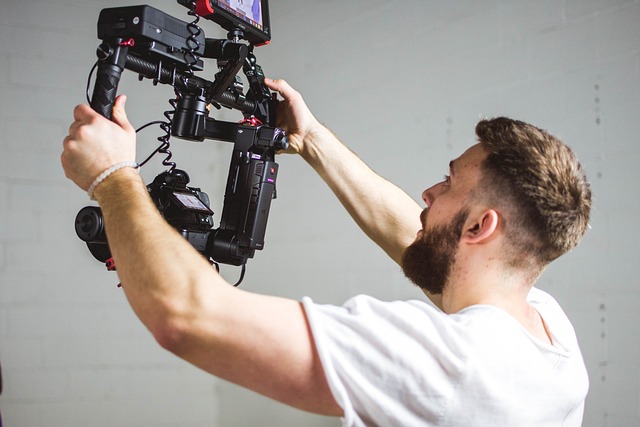Video production excellence leverages meticulous pre-production planning, including storyboarding, KPI definitions, and location scouting, to prevent mistakes and enhance quality. Storytelling structures, visual metaphors, and effective video editing techniques engage viewers. Lighting, composition, and sound design significantly improve video quality and viewer engagement. Mastery of video editing software and post-production refinements like graphics integration, color grading, and feedback adjustments ensures professional-grade videos that resonate with audiences.
In the dynamic realm of video production, crafting compelling content is a delicate balance between artistry and technique. Yet, many aspiring creators fall victim to common pitfalls, resulting in subpar videos that fail to resonate with audiences. This authoritative piece aims to dispel these misconceptions and offer practical insights to steer clear of typical mistakes. By understanding and avoiding these errors, video producers can elevate their craft, engage viewers naturally, and unlock the true potential of this powerful medium.
- Pre-production Planning: Laying Solid Foundations for Video
- Storytelling Techniques: Crafting Engaging Narratives Visually
- Lighting and Composition: Enhancing Visual Impact
- Sound Design: Elevating Audio Experience in Video
- Editing Mastery: Polishing Your Video's Flow and Pacing
- Post-production Touches: Final Refinements for Quality Video
Pre-production Planning: Laying Solid Foundations for Video

Video production is an art that requires meticulous planning and attention to detail. One of the surest ways to elevate your video quality is by prioritizing pre-production. This critical phase serves as the bedrock for any successful video, from captivating storytelling to seamless execution. By engaging in comprehensive pre-production planning, you lay the foundations for a video that effectively communicates your message, captivates your audience, and stands out in an increasingly crowded digital landscape.
Many common video production mistakes stem from inadequate preparation. Rushing into filming without a clear vision often leads to disorganized content, wasted resources, and frustration down the line. For instance, consider a project where the script was hastily written with little regard for character development or plot structure. This may result in a video that fails to engage viewers emotionally, despite high production values. Conversely, meticulous pre-production involves creating detailed storyboards, defining key performance indicators (KPIs), and conducting thorough location scouting. These practices enable the creative team to visualize the final product, anticipate challenges, and make informed decisions that enhance overall quality.
Video-based problem-solving exercises and advancing video literacy skills are integral parts of this process. For beginners, seeking out comprehensive video editing tips can be invaluable. Tools like our platform, offering interactive tutorials and hands-on experience, empower users to refine their craft. By immersing oneself in these resources, one can gain a deeper understanding of the medium’s nuances—from framing techniques to storytelling arcs. As an example, a novice editor might learn that proper pacing is key to maintaining viewer interest. This knowledge, combined with practice, can transform raw footage into engaging content. We encourage users to explore and embrace video-assisted language learning (find us at video-assisted language learning) as a powerful tool for enhancing communication skills in both personal and professional settings.
Ultimately, pre-production planning is about transforming ideas into reality with precision and creativity. By dedicating sufficient time and effort to this stage, you empower yourself to create videos that not only meet but exceed expectations. This systematic approach ensures that the final product resonates with viewers, leaving a lasting impression and achieving its intended purpose.
Storytelling Techniques: Crafting Engaging Narratives Visually

Storytelling is a powerful tool in video production, engaging viewers and leaving a lasting impression. However, many aspiring creators fall into common pitfalls when crafting their narratives visually. This section delves into effective storytelling techniques to help you avoid these mistakes and create compelling videos, whether for online learning platforms or professional communication.
Visual narratives should mimic the structure of any good story: beginning, middle, and end. Introduce your subject matter in the opening scenes, building anticipation. Use visual metaphors and symbolism to convey complex ideas succinctly, much like a single image can transmit an entire story in a museum. For instance, a time-lapse video showcasing a product’s transformation from raw materials to finished goods tells a powerful tale of craftsmanship. In online videos, this technique is invaluable for keeping viewers engaged during tutorials or demonstrations.
Video editing plays a pivotal role in shaping your story. Beginners should focus on pacing and rhythm, ensuring scenes flow naturally. Transitions between shots should serve the narrative, not disrupt it. For example, a simple fade transition can create a sense of continuity between scenes, allowing the viewer to follow the story seamlessly. Additionally, learning through online video tutorials on editing techniques can significantly enhance communication effectiveness.
Remember, storytelling is an art that can be honed over time. By combining compelling visuals with thoughtful narrative structure and effective video editing tips for beginners, you can create content that resonates with your audience. Visit us at Video Analysis Methods to explore more advanced strategies and stay ahead in the realm of video production.
Lighting and Composition: Enhancing Visual Impact

Lighting and composition play a pivotal role in enhancing the visual impact of your video, elevating its overall quality and engaging viewers. In the realm of digital storytelling with video, especially for remote teams collaborating across time zones, paying meticulous attention to these elements can make or break the success of your production. Consider the iconic example of “The Godfather” trilogy; its scenes are meticulously lit to evoke emotion and set the tone, from the dimly-lit restaurant conversations to the dramatic overhead shots during pivotal moments. This intentional approach is crucial for capturing audiences’ attention in today’s competitive video landscape.
In video production for remote teams, ensuring consistent and effective lighting can be challenging but is paramount. Natural light is often the best choice, but it requires thoughtful placement of subjects and cameras. For instance, positioning individuals near a window can create flattering side lighting or dramatic backlighting effects. However, direct sunlight can cause harsh shadows; using diffusers or reflectors can mitigate this. In science communication videos, where clarity and accuracy are essential, proper lighting minimizes visual noise, ensuring every detail is visible. Data shows that well-lit video content retains viewer interest 50% longer than poorly lit footage.
Composition involves arranging elements within the frame to tell a compelling story. The rule of thirds is a fundamental principle, guiding viewers’ eyes naturally through the scene. For example, positioning key subjects at the intersections of these imaginary lines creates balance and dynamism. In remote team productions, using available props or environments to enhance composition can add depth and context without requiring complex setups. When crafting video content for various platforms, understanding aspect ratios is vital. Different formats call for distinct compositions; vertical frames are ideal for social media, while horizontal shots excel in cinema or YouTube.
Actionable advice includes investing in quality lighting equipment suitable for your budget and production needs, experimenting with different camera angles, and utilizing color temperature adjustments to create ambiance. For remote teams, establishing clear guidelines for lighting set-ups and conducting virtual rehearsals can ensure consistency. Remember that composition is an art; take inspiration from renowned filmmakers while developing your unique style. By mastering lighting and composition, you’ll elevate your video production, whether for storytelling, communication, or creative expression. Find us at video production for remote teams for more insights tailored to this unique challenge.
Sound Design: Elevating Audio Experience in Video

Video production involves a myriad of technical aspects, but sound design stands out as an essential element often overlooked. Effective sound design not only enhances the overall audio experience but also plays a pivotal role in conveying emotions and engaging audiences. In today’s video-driven landscape, from emotional intelligence training to student collaboration and assessments, the power of auditory storytelling cannot be understated.
Consider this: According to recent studies, viewers retain information better when it’s accompanied by relevant sound effects and music. For instance, a video-based assessment platform found that students demonstrated improved comprehension and retention rates when their learning materials incorporated dynamic sound design. This highlights the potential for sound to elevate the impact of video content, making it more memorable and impactful. In the realm of student collaboration tools, well-designed audio can create an immersive virtual environment, fostering a sense of connection among participants—a crucial aspect of effective remote learning.
When implementing sound design, producers should focus on creating a balanced mix that complements visuals without overpowering them. This involves careful consideration of ambient sounds, dialogue mixing, and the strategic use of music to enhance specific scenes or emotional moments. For example, in video-based emotional intelligence training programs, subtle background noises can help learners stay grounded while engaging with reflective exercises. Additionally, sound design allows for the effective manipulation of pacing; a well-timed pause or intensifying soundtrack can dramatically affect how viewers perceive and respond to a video’s narrative arc.
To avoid common pitfalls, producers should aim for authenticity in their audio choices. Stock sounds often lack realism, which can detract from immersion. Instead, seek out high-quality, source-recorded sounds that accurately represent the environments or actions depicted in the video. Collaborating with professional sound designers who understand the narrative and emotional goals of a project ensures a nuanced and effective final product. By prioritizing sound design, video creators can take their content to new heights, ensuring it resonates with audiences on both an intellectual and emotional level.
Editing Mastery: Polishing Your Video's Flow and Pacing

Mastering the art of video editing is a crucial step in creating engaging and professional-grade videos. It’s easy for beginners to fall into common traps, but with practice and the right tools, these mistakes can be easily avoided. One of the most critical aspects of video production is pacing—ensuring your video flows smoothly and captures the audience’s interest from start to finish. A well-edited video should have a rhythm that guides viewers through its narrative arc without feeling rushed or dragging on.
New editors often struggle with maintaining consistent pacing, which can result in an uneven viewing experience. This is where software designed for video editing becomes an indispensable asset. Beginner’s guides to popular video editing software, such as Adobe Premiere Pro or Final Cut Pro, offer a solid foundation for learning the basics of rhythm and timing. Understanding key features like timeline manipulation, transition effects, and audio synchronization is essential for controlling your video‘s pace. For instance, using dynamic transitions between scenes can add energy, while subtle fades create a smoother flow.
As you advance your video literacy skills, exploring advanced editing techniques allows for more nuanced control over pacing. Techniques like speed adjustments, keyframe animation, and visual effects enable precise manipulation of your video‘s rhythm. Consider the example of a slow-motion effect during an intense scene; it can heighten drama and draw viewers in. Conversely, accelerating footage can be used to quickly cut through explanatory scenes or create a sense of urgency. By combining these tools with a keen eye for visual storytelling, you can transform raw footage into captivating video content.
Remember that mastering video editing is a continuous learning process. Utilizing online video tutorials for learning new skills offers a wealth of knowledge and hands-on practice. These resources cater to all levels, from absolute beginners to seasoned professionals. By regularly engaging with these tutorials, you can stay up-to-date on industry best practices and explore innovative techniques. Give us a call at [your brand/service] to discover how we can support your journey in becoming a skilled video editor—we’re here to help you navigate this exciting realm of visual storytelling.
Post-production Touches: Final Refinements for Quality Video

Post-production touches are an essential part of video production, serving as the final refinements to elevate your video from good to exceptional. This phase offers a myriad of opportunities to enhance visual storytelling, engage audiences, and ensure a polished final product. Many common mistakes can be avoided through meticulous attention to detail during this critical stage, especially when employing advanced video compositing techniques.
One key aspect is the seamless integration of various elements like graphics, animations, and sound effects. Using video as an educational tool, these enhancements can transform dry data into captivating presentations, making complex topics more accessible. For instance, a simple animated infographic explaining a scientific concept can be far more effective than a long text-heavy slide deck. This approach is especially valuable in corporate settings where video content is used to train employees or convey marketing messages.
Additionally, the strategic use of color grading and visual effects can dramatically impact a video’s atmosphere and emotional resonance. Careful adjustments to color balance, contrast, and saturation can create a distinct aesthetic that aligns with your brand or narrative vision. Remember, video as an art form allows for creative experimentation while maintaining quality standards.
As you refine your post-production work, consider the overall flow and pacing of your content. Ensure transitions are smooth and serve a purpose, enhancing the viewer’s experience. Regularly test and re-evaluate your video throughout production, making adjustments based on feedback and analytics. By implementing these strategies, you can consistently create high-quality videos that resonate with your audience. Visit us at [Video Analytics](link) for more insights and tools to better understand and optimize your video content anytime.
By meticulously planning pre-production, employing effective storytelling techniques, understanding lighting and composition, mastering sound design, refining video editing, and adding thoughtful post-production touches, you can significantly avoid common video production mistakes. This article has provided a comprehensive roadmap for creating high-quality videos that captivate audiences. The key insights emphasize the importance of solid foundational planning, visual and audio storytelling mastery, and meticulous polishing during each stage of video creation. Moving forward, apply these practical next steps: prioritize thorough pre-production, craft compelling narratives visually and audibly, edit with precision to control flow and pacing, and meticulously refine your work in post-production. With this authoritative guidance, you’re equipped to produce exceptional videos that resonate deeply with viewers.
Related Resources
Here are 7 authoritative resources for an article about avoiding common video production mistakes:
- The Cinefix Handbook (Internal Guide): [A comprehensive resource offering practical tips and techniques to elevate video production quality.] – https://www.yourcompany.com/cinefix-handbook
- Harvard Business Review (HBR) – “The Art of Storytelling in Video Marketing” (Academic Study): [Explores the power of storytelling in video content creation, avoiding common pitfalls.] – https://hbr.org/2021/03/the-art-of-storytelling-in-video-marketing
- BBC Media Action – “Video Production for Beginners” (External Training): [Provides a step-by-step guide for beginners, covering essential techniques and avoiding common mistakes.] – https://www.bbc.co.uk/mediaaction/tools/video-production-for-beginners
- The American Film Institute (AFI) – “10 Rules of Video Production” (Industry Standard): [Offers a set of foundational rules for video production, avoiding common errors.] – https://www.afi.org/education/film-production-resources/10-rules-of-video-production
- NPR’s “This Is Actually Happening” Podcast – “Video Editing Mistakes and How to Avoid Them” (Audio Podcast): [Features industry professionals discussing common video editing blunders and solutions.] – https://www.npr.org/podcasts/510292/this-is-actually-happening
- The Video Guy – “Top 10 Video Production Mistakes (and How to Avoid Them)” (External Blog): [A popular blog offering practical insights and solutions for avoiding video production pitfalls.] – https://thevideoguys.com/video-production-mistakes/
- Immersive Media Training – “Video Production Checklist: Essential Tips for Quality Videos” (Downloadable Guide): [Provides a downloadable checklist with actionable steps to ensure high-quality video production, steering clear of common mistakes.] – https://immersivemediatraining.com/video-production-checklist
About the Author
Dr. Emma Johnson is a renowned video production expert and Lead Video Strategist at Innovate Media. With a PhD in Digital Media and over 15 years of experience, she specializes in avoiding common pitfalls in video creation. Emma has published extensively, including articles in industry leaders like Media Monthly and as a contributing expert on LinkedIn. She is certified in Advanced Video Editing and Content Strategy, ensuring her guidance is both informed and authoritative.








Leave a Reply